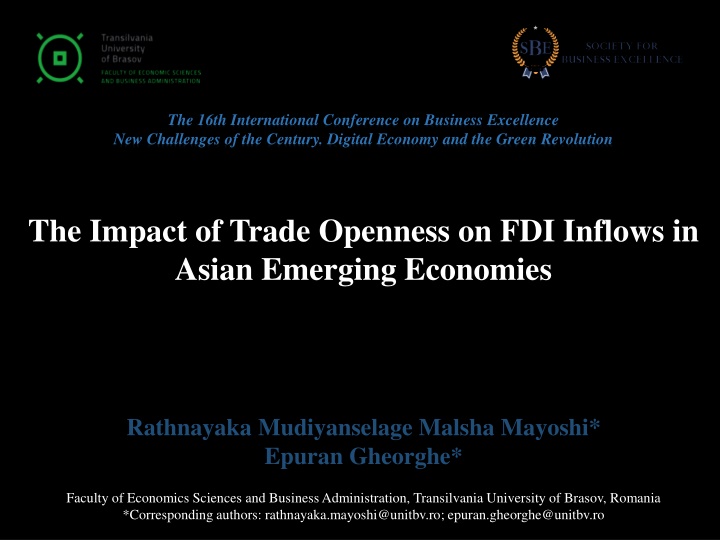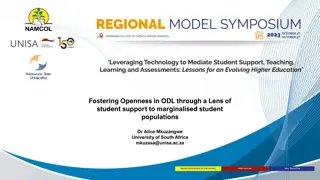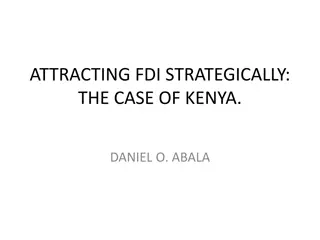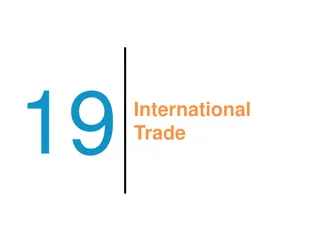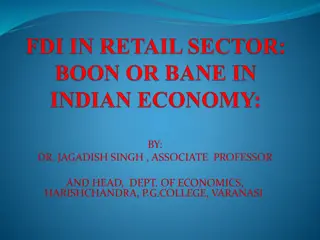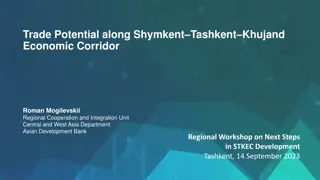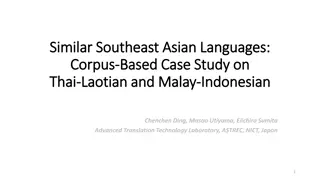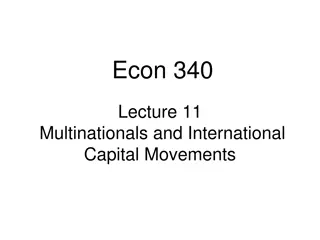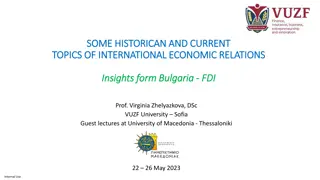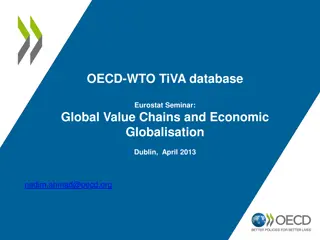Impact of Trade Openness on FDI in Asian Emerging Economies
The 16th International Conference on Business Excellence highlighted the significance of trade openness on FDI in Asian emerging markets. Various studies have shown both positive and negative effects, with countries like Turkey, Romania, and Sub-Saharan Africa providing insights into the causal relationship. Understanding the dynamics of trade openness and FDI is crucial for policymakers and businesses operating in these regions.
Download Presentation

Please find below an Image/Link to download the presentation.
The content on the website is provided AS IS for your information and personal use only. It may not be sold, licensed, or shared on other websites without obtaining consent from the author.If you encounter any issues during the download, it is possible that the publisher has removed the file from their server.
You are allowed to download the files provided on this website for personal or commercial use, subject to the condition that they are used lawfully. All files are the property of their respective owners.
The content on the website is provided AS IS for your information and personal use only. It may not be sold, licensed, or shared on other websites without obtaining consent from the author.
E N D
Presentation Transcript
The 16th International Conference on Business Excellence New Challenges of the Century. Digital Economy and the Green Revolution The Impact of Trade Openness on FDI Inflows in Asian Emerging Economies Rathnayaka Mudiyanselage Malsha Mayoshi* Epuran Gheorghe* Faculty of Economics Sciences and Business Administration, Transilvania University of Brasov, Romania *Corresponding authors: rathnayaka.mayoshi@unitbv.ro; epuran.gheorghe@unitbv.ro
1. INTRODUCTION 2. LITERATURE REVIEW 3. RESEARCH GAP, PROBLEM STATEMENT, OBJECTIVE OF THE STUDY, SIGNIFICANCE OF THE STUDY OF 4. MATERIALS AND METHODOLOGY 5. RESULTS AND DISCUSSION 6. CONCLUSION AND POLICY RECOMMENDATION
1. INTRODUCTION The Asian emerging market is considered as one of the prime location for foreign direct investment. Geographic region with natural resources High labour force WHY? Best place for international trade activities Regional integration, connectivity, FDI prospects Asia is the world s largest foreign direct investment recipient, hosting more than 30% of global inflows in 2019 (United Nations Conference on Trade and Development (2020). China, Singapore, and Vietnam are considered more FDI-received countries in the Asia-Pacific region (World Bank, 2020). India has received the largest foreign direct investment in South Asia (United Nations Conference on Trade and Development (2020).
What is Trade Openness ? The sum of imports and exports normalized by gross domestic product (Kandiero & Chitiga, 2006; Liargovas & Skandalis, 2012; Cantah et al., 2014; Zaman et al., 2018; Rathnayaka Mudiyanselage et al., 2021). The high trade openness ratio indicates that the host country's trade barriers for products and services have been gradually decreased or removed. The impact of trade openness on FDI inflows can be positive, negative or insignificant.
2. LITERATURE REVIEW Author Topic Methodology Findings Zaman et al. (2018) Trade Openness and FDI Inflows: A Comparative Study of Asian Countries. Panel (Fixed effect and Pooled ordinary least square methods) Trade openness encouraged FDI flows to the selected Asian countries (India, Iran, and Pakistan). Cantah et al. (2014) Foreign direct investment and trade policy openness in Sub-Saharan Africa. Generalized Method of Moments Approach Policy openness affects FDI inflows positively. Rathnayaka Mudiyanselage et al. (2021) Causal links between trade openness and FDI inflows in Romania. ARDL bound test and Granger causality test Trade openness negatively impacts inward FDI in Romania, and the result of the Granger causality test indicated that Romania has a unidirectional relationship between trade openness and FDI. G ri and G zg r (2015) Trade Openness and FDI Inflows in Turkey. Granger causality analysis The direction of the causality runs from trade openness to FDI inflows.
3.1 Research Gap No study has used recent data and sophisticated econometric techniques to examine the impact of trade openness, on FDI inflows into Asian emerging economies. 3.2 Problem Statement Many empirical studies have examined the relationship between trade openness and foreign direct investment in single country case studies, cross country analysis in other regions. Example: (Janicki & Wunnava, 2004; Liargovas & Skandalis, 2012; G R & G ZG R, 2015; Gunawardhana & Damayanthi, 2019 and Hinto ov , Bruothov , Kub kov , & Ru insk , 2018 and Makoni, 2018; etc.) Is there any long-run and short-run impact of trade openness on FDI inflows in Asian emerging economies for the period from 1996 to 2019? 3.3 Objective of the Study The objective of this study is to identify the impact of trade openness on FDI inflows into Asian emerging economies. . 3.4 Significance of the Study Foreign direct investment and trade openness are the main determinants of the economic growth, it is important to get a clear idea about the direction and strength of the association between foreign direct investment and trade openness.
4. MATERIALS AND METHODOLOGY 4.1 Data and Sources Study Period: 1996-2019 Sample Countries (Bangladesh, China, India, Malaysia, Pakistan, Philippines, Singapore, South Korea, Sri Lanka, Thailand, and Vietnam). 4.2 Description of the Variables Variable Unit/Proxy Foreign Direct Investment Net Inflows (FDI) Trade Openness (TOP) Gross Domestic Product (GDP) Population Size (POP) Inflation (INF) Mobile cellular subscriptions (MOB) Gross fixed capital formation (GCF) Total Reserves (RES) Current USD (Export+Imports)/GDP Current USD Population, total Consumer price index- annual % Per 100 people Current USD Current USD Source: Authors own research based on WDI, 2020.
4.3 Model Specification The model (1) could be specified as follows ?????= ?(?????,?????,?????,?????,?????,?????,?????) ? In an econometric form, equation (1) can be stated as: ????? = ??+ ????????+ ?????????+ ?????????+ ????????+ ???????? + ?????????+ ?????????+??? (?) Where, 1i to 7i are the slope coefficients and ??? is the white noise error term, the subscript i=1, ,11 represents the country index, and the subscript t=1996, ,2019 represents the year.
The ARDL equation can be written as follows (3): ???? = ??+ ?? ?????,? ?+ ?? ????,? ?+ ?? ?????,? ?+ ?? ?????,? ?+ ?? ????,? ?+ ?? ????,? ? ? ? ?????,? ?+ ? ? + ?? ?????,? ?+ ?? ?????,? ?+ ? ????,? ?+ ? ?????,? ? ?=? ?=? ?=? ? ? ? ? + ? ?????,? ?+ ? ????,? ?+ ? ????,? ?+ ? ?????,? ? ?=? ? ?=? ?=? ?=? + ? ?????,? ?+ ??+ ??? (? ?=? 4.4 Estimation Techniques Cross-sectional Dependence Tests Unit root tests (1st and 2nd ) Panel cointegration test PMG/ARDL model capture the long-run and short-run relationship among the variables. Panel Granger Causality test (E-views 10
5. RESULTS AND DISCUSSION 5.1 Descriptive Statistics LFDI TOP LGDP LPOP INF MOB LGCF LRES Mean 22.33 106 26.22 18.29 4.63 64.82 24.87 24.55 Median 22.42 71.71 26.07 18.21 3.78 65.57 24.55 24.62 Maximum 26.40 437.3 30.29 21.06 23.12 186.16 29.44 28.99 Minimum 16.42 21.93 23.36 15.12 -1.71 0.00 21.92 20.85 Source: Researchers calculation using E-Views 10.
5.2 Unit Root Test Variable Level LLC IPS ADF-Fisher PP-Fisher LFDI TOP LGDP LPOP INF MOB LGCF LRES -1.51 -0.01 0.44 -7.22 -5.85* -2.08** 1.55 -3.96 -1.38 0.72 4.07 -2.03 -5.44* 1.70 3.77 -0.40 39.3 19.13 9.18 45.68 68.14* 21.16* 8.15 26.61 53.78 19.33 2.09 433.32 82.20* 19.87 4.01 25.16 Variable First Difference LLC IPS ADF-Fisher PP-Fisher LFDI TOP LGDP LPOP INF MOB LGCF LRES -7.49* -11.48* -8.02* -3.26* -16.46* -3.33* -6.29* -8.68* -9.59* -11.26* -6.72* -2.94* -16.89* -4.48* -5.86* -8.88* 125.01* 144.43* 85.73* 40.84* 213.04* 56.88* 74.52* 114.99* 610.12* 148.86* 92.04* 46.68* 863.56* 50.52* 53.78* 119.35* Note: *, **, and *** denote statistically significant values at the levels of 1%, and 5%, respectively. The software E-Views 10 was used to calculate LLC, IPS, ADF-Fisher, and PP-Fisher. Source: Researchers calculation using E-Views 10
4.3 Results for Cointegration Tests ?0= ?? ????????????? ?0= ? ??? ?? ????????????? Kao Cointegration Test t-Statistics Probability ADF (AIC) -9.2834 0.3880 0.2067 0.0000* Residual Variance HAC Variance 5.4 PMG/ARDL Long-run Estimation Results Variable Coefficient t-value P-value TOP LGDP LPOP INF MOB LGCF LRES 0.0059 0.0076 -0.2195 0.0714 -0.0014 1.0123 0.2643 3.3151 0.0178 -0.1670 9.3328 -0.6631 3.6282 2.0691 0.0011* 0.9858 0.8676 0.0000* 0.5082 0.0004* 0.0402** Note: *, **, and *** denote statistically significant values at the levels of 1%, 5%, and 10%, respectively. Source: Researchers calculation using E-Views 10.
5.5 PMG/ARDL Short-run Estimation Results Variable Coefficient t-value P-value ECT(-1) D(TOP) D(LGDP) D(LPOP) D(INF) D(MOB) D(LGCF) D(LRES) C -0.7595 0.0068 0.7533 41.9502 -0.0017 0.0100 1.0116 0.1131 -5.2881 -7.5886 0.7098 0.5459 1.3101 -0.0818 0.9353 0.8658 0.3765 -6.9344 0.0000* 0.4789 0.5859 0.1921 0.9349 0.3510 0.0639** 0.7071 0.0000* Note: *, **, and *** denote statistically significant values at the levels of 1%, 5%, and 10%, respectively. Source: Researchers calculation using E-Views 10. 4.6 Panel Granger Causality Test Results (Dumitrescu-Hurlin) Null Hypothesis W-Stat. 4.3181 2.3796 Zbar-Stat. Prob. 0.0087*** 0.8851 TOP does not homogeneously cause LFDI LFDI does not homogeneously cause TOP 2.6249 0.1445 Note: *, **, and *** denote statistically significant values at the levels of 1%, 5%, and 10%, respectively. Source: Researchers calculation using E-Views 10.
6. CONCLUSION AND POLICY RECOMMENDATION The findings showed that while emerging market economies in Asia are more open to trade, they have also become more attractive FDI destinations. Dumitrescu-Hurlin Granger causality test indicated that Asian emerging countries have a unidirectional causal relationship between trade openness and FDI inflows throughout the period. Trade openness is not only factor that can attract more FDI into the region. There are many factors impact on FDI inflows. Based on the findings, it is better to promote strong open trade policies in order to increase the investment climate in Asian emerging economies.
Limitation of the Study Variable and Time Period Data unavailability in some of the Asian emerging countries (leaves out crucial variables). Future Research Works Examine how sector-specific trade openness, such as manufacturing, services, and agriculture, impacts FDI inflows in Asian emerging economies. Acknowledgement This study is a portion of my Ph.D. research (The causal links between trade openness and FDI), which I conducted at Transilvania University of Brasov, Romania, under the supervision of Prof. Dr. Epuran Gheorghe.
Thank You ! 16
